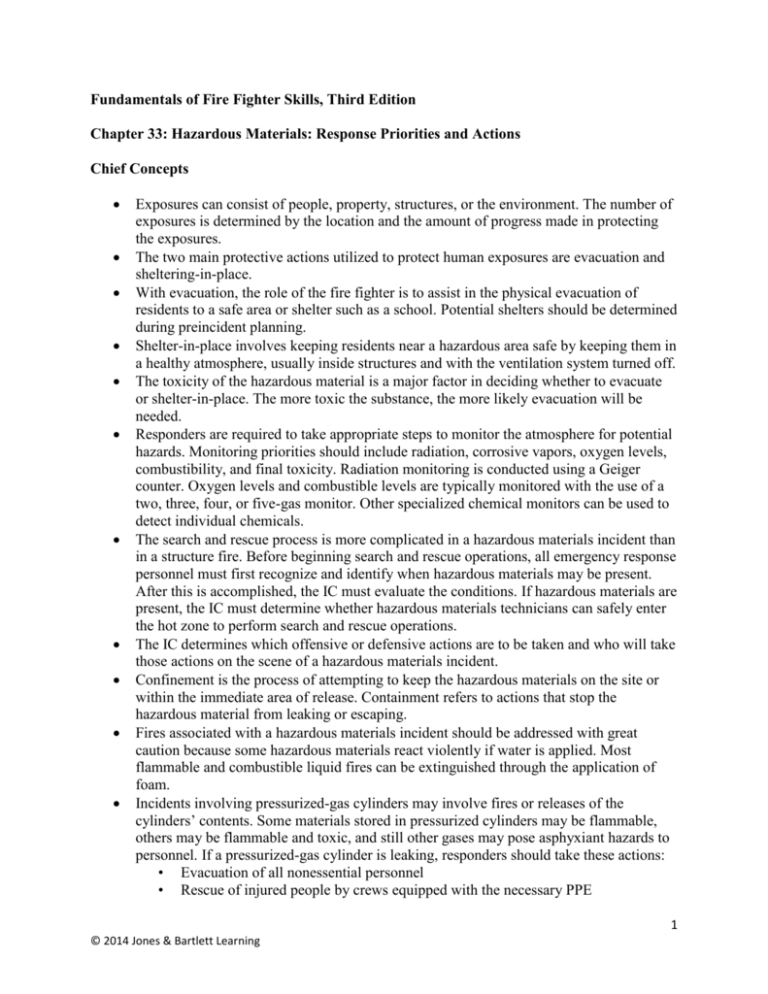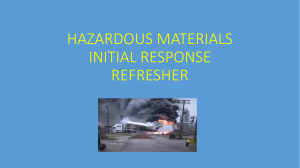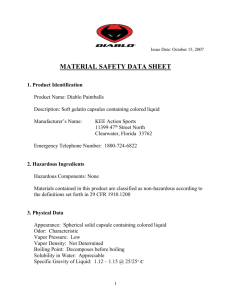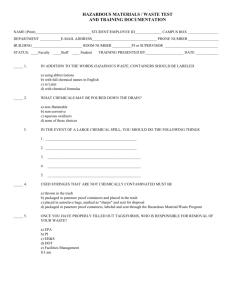Chapter 33: Hazardous Materials - Fundamentals of Fire Fighter
advertisement

Fundamentals of Fire Fighter Skills, Third Edition Chapter 33: Hazardous Materials: Response Priorities and Actions Chief Concepts Exposures can consist of people, property, structures, or the environment. The number of exposures is determined by the location and the amount of progress made in protecting the exposures. The two main protective actions utilized to protect human exposures are evacuation and sheltering-in-place. With evacuation, the role of the fire fighter is to assist in the physical evacuation of residents to a safe area or shelter such as a school. Potential shelters should be determined during preincident planning. Shelter-in-place involves keeping residents near a hazardous area safe by keeping them in a healthy atmosphere, usually inside structures and with the ventilation system turned off. The toxicity of the hazardous material is a major factor in deciding whether to evacuate or shelter-in-place. The more toxic the substance, the more likely evacuation will be needed. Responders are required to take appropriate steps to monitor the atmosphere for potential hazards. Monitoring priorities should include radiation, corrosive vapors, oxygen levels, combustibility, and final toxicity. Radiation monitoring is conducted using a Geiger counter. Oxygen levels and combustible levels are typically monitored with the use of a two, three, four, or five-gas monitor. Other specialized chemical monitors can be used to detect individual chemicals. The search and rescue process is more complicated in a hazardous materials incident than in a structure fire. Before beginning search and rescue operations, all emergency response personnel must first recognize and identify when hazardous materials may be present. After this is accomplished, the IC must evaluate the conditions. If hazardous materials are present, the IC must determine whether hazardous materials technicians can safely enter the hot zone to perform search and rescue operations. The IC determines which offensive or defensive actions are to be taken and who will take those actions on the scene of a hazardous materials incident. Confinement is the process of attempting to keep the hazardous materials on the site or within the immediate area of release. Containment refers to actions that stop the hazardous material from leaking or escaping. Fires associated with a hazardous materials incident should be addressed with great caution because some hazardous materials react violently if water is applied. Most flammable and combustible liquid fires can be extinguished through the application of foam. Incidents involving pressurized-gas cylinders may involve fires or releases of the cylinders’ contents. Some materials stored in pressurized cylinders may be flammable, others may be flammable and toxic, and still other gases may pose asphyxiant hazards to personnel. If a pressurized-gas cylinder is leaking, responders should take these actions: • Evacuation of all nonessential personnel • Rescue of injured people by crews equipped with the necessary PPE 1 © 2014 Jones & Bartlett Learning • Corrective action to minimize the leak or at least minimize exposure to people and equipment • Assurance that all necessary resources are available for the final resolution of the situation • Firefighting action • Decontamination • Written documentation and critique Hazardous materials control activities include the following: • Absorption/adsorption—Techniques for holding a hazardous material to make collection and disposal easier. • Diking—Emplacement of an impervious material to form a barrier that will keep a hazardous material from entering an area. • Damming—Includes complete dams, overflow dams, and underflow dams. A complete dam completely stops the flow of materials through a channel. An overflow dam uses piping to trap the material at the base of the dam. An underflow dam allows water to flow through piping under the dam and collects the hazardous material at the top of the dam. • Diversion—Redirection of the flow of a liquid from an area. • Retention—Creation of an area to hold hazardous materials. • Dilution—Addition of water or another liquid to weaken the strength or concentration of a hazardous material. • Vapor dispersion—Lowering the concentration of vapors by spreading them out. • Vapor suppression—Controlling fumes or vapors that are given off by certain materials. • Identify and isolate a remote shut-off valve—Many systems have a way to remotely shut down a system. After all of the factors have been considered, the IC may decide that the hazardous materials incident cannot be handled without unnecessary risks and that all personnel should withdraw. The recovery phase of a hazardous materials incident occurs when the imminent danger to people, property, and the environment has passed or is controlled, and clean-up begins. During this phase, state and federal agencies may become involved in cleaning up the site, determining the responsible party, and implementing cost-recovery methods. The recovery phase in large-scale incidents can last for days, weeks, or even months and may require resources and equipment beyond those available to local responders. If a hazardous materials incident involves potential criminal or terrorist activity, responders must notify law enforcement and appropriate federal agencies. Specific activities should be implemented to ensure safety, such as isolating the scene. 2 © 2014 Jones & Bartlett Learning








